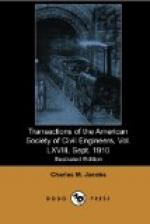The plans contemplate that passengers to and from the lower part of Manhattan will be carried by the steam line between Newark and Jersey City and cross the North River by ferry or the Cortlandt Street tunnels of the Hudson Company. Eventually, the old main line will be electrified and supersede the steam service between Newark and Jersey City.
The Greenville Yard is the most important point for the receipt, transmission, and distribution of freight. From this point freight can be transported, without breaking bulk, by a comparatively short car-ferry to the Long Island Railroad terminus at Bay Ridge, and thus a very large part of the Pennsylvania Railroad Company’s floatage in New York Harbor and the East River will be abolished, the floatage distance being reduced in the case of the New England freight from about 12 to 3 miles. This traffic will be routed from Bay Ridge via the Long Island Railroad to a connection with and thence over the New York Connecting Railroad to the New York, New Haven and Hartford Railroad at Port Morris, N. Y.
As the facilities for the handling of freight in the Boroughs of Brooklyn and Queens had become insufficient for taking care of the prospective traffic, eleven new local delivery yards, having a combined area of about 2,153 city lots, have been established, and three existing yards are to be improved and enlarged so as to give a combined area of about 687 city lots. Of these new yards, the Bay Ridge freight terminal, containing about 790 city lots, is the largest; its functions have been described above. There is a freight terminal at East New York 200 ft. wide and a mile long, containing about 566 city lots, which will be the distributing point of freight for the entire East New York section. This yard is depressed, and will be crossed by six viaducts carrying city streets. The North Shore freight yard, containing 109 city lots, is connected with the Montauk Division by an overhead construction, known as the Montauk Freight Cut-Off, whereby all freight traffic to Jamaica may be kept out of the way of the Jamaica passenger traffic from the tunnels.
It may be of interest to indicate briefly how much has already been accomplished in the execution of this general plan, and what still remains to be done for its completion.
The larger part of the electrification of the Long Island Railroad and the elimination of grade crossings within the built-up city limits, the Atlantic Avenue improvement, and the yard and piers at Greenville, have been completed. The Sunnyside Yard and the Glendale Cut-Off will be completed during the next twelve months. On the Tunnel and Terminal Railroad the embankment and bridge work across the Hackensack Meadows and all the tunnels and excavation from the west side of Bergen Hill to Long Island City, except a short section near the eastern end of the line, have been completed. The New York station and other buildings and facilities connected therewith are well advanced. The laying of the track, the electrification of the line, and the installation of the signaling and lighting systems are under way. It is anticipated that the line will be ready for operation in the spring of 1910.




